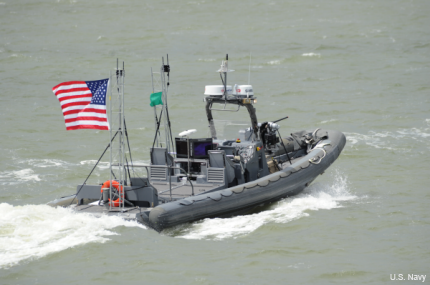Navy puts autonomous 'swarmboats' into action
In a breakthrough demonstration, 13 boats operating autonomously or by remote worked together to escort a high-value vessel and surround a mock enemy.

Navy researchers have achieved a breakthrough in autonomous technology, developing a “swarming” system that employs multiple unmanned boats working together to escort ships, patrol harbors or confront adversaries.
Developed by the Office of Naval Research, the Control Architecture for Robotic Agent Command and Sensing, or CARACaS, system can, for the cost of several thousand dollars, turn just about any boat into an unmanned vessel, according to Rear Adm. Matthew L. Klunder, chief of Naval Research.
During a two-week demonstration in August, as many as 13 patrol boats and other vehicles outfitted with the CARACaS sensor and software kit worked in concert—either autonomously or by remote—on the James River in Virginia, escorting a high-value vessel (in this case, the researchers’ ship, the Relentless), which is and then surrounding a mock enemy ship when it appeared. Although the purpose was to demonstrate the boats’ ability to swarm, boats operated by remote could have fired on the intruding ship as well, Klunder said during a recent conference call with reporters.
The Navy sees a lot of advantages in having “swarmboats.” They’re cheaper than manned boats, and in addition to keeping sailors out of harm’s way, they keep sailors who otherwise would be sent out on patrol from being pulled away from their assigned jobs aboard ship. And the kits can take advantage of smaller boats already aboard cruisers, destroyer and carriers, without the need to buy new vessels.
“We think this is extremely effective and extremely affordable,” Klunder said. Boats can be outfitted with payloads ranging from non-lethal to lethal, and while the James River demonstration involved 13 boats, he said as many as 20 or 30 could be deployed as a unit, controlled by a single operator.
Teams of these unmanned surface vehicles, or USVs, could help prevent terrorist strikes such as the attack on the USS Cole in October 2000, when a small boat loaded with explosives pulled up alongside the Cole, a guided missile destroyer, as it was refueling in the harbor at Aden, Yemen. Terrorists set off the explosives, ripping a hole in the side of the ship, killing 17 sailors and injuring 39 others in the deadliest attack on a U.S. Navy vessel since 1987.
Although that attack isn’t the only reason for developing the technology, it is something researchers said they have kept in mind. “The systems we put in the water [on the James River] would have prevented the Cole,” Klunder said.
Networked unmanned vehicles capable of working together—whether in the air, at sea or on land—has been a goal of the military for years, and is mentioned in the Pentagon’s 25-year-plan, Unmanned Systems Integrated Roadmap, released in January. But efforts at airborne swarming, including one by ONR and one by the Defense Advanced Research Projects Agency, are in the early stages. CARACaS represents a leap forward.
Klunder said a decision on deploying the system isn’t up to ONR, but that “all indications are that we’ll have that inside a year.” And although they’ve used smaller patrol boats, “we can certainly upgrade this to larger vessels,” he said.

Eight unmanned high-speed maneuvering surface targets, at right, lead the way as five unmanned surface vehicles escort the Relentless.
The basic technology started with software used in NASA’s Mars Rover. ONR took that and developed the autonomous swarming capability—which combines artificial intelligence, machine perception and distributed data fusion—collaborating with researchers from warfare centers, industry, academia and university-affiliated research centers, along with support from the Coast Guard and Navy.
And they worked quickly. “We turned this whole demonstration around in nine months,” Klunder said. And he expects that, now that CARACaS is a reality, new developments will follow soon, for UAVs and UUVs (underwater) as well as USVs. “This train is moving very fast,” he said. Commercial applications are likely as well, such as to protect merchant vessels, harbors or oil tankers.
To protect against autonomous boats going off on their own, CARACaS has two backup systems each with independent kill switches, so a boat can be shut down if need be, said Dr. Robert Brizzolara, ONR program manager, who also spoke on the conference call. As for weapons control, that’s in the hands of a sailor operating a boat remotely, Klunder said, adding that the Navy has protocols, training programs and established practices to ensure safe operations.
NEXT STORY: Air Force fires back at IG over Reaper buys



